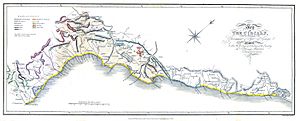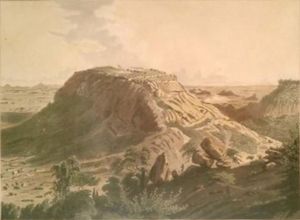Benjamin Heyne facts for kids
Benjamin Heyne (born 1770, Germany – died 6 February 1819, India) was a German botanist, naturalist, and surgeon. He worked in British India for the British East India Company as a botanist in the Madras Presidency. He was known for collecting and describing many plants from southern India. Some plants were even named after him by other European botanists.
Life and Discoveries in India
Benjamin Heyne was born in Döbra, Germany. His father was a famous scholar named Christian Gottlob Heyne. Benjamin later joined a mission in Tranquebar where he became very interested in botanical gardens.
Around 1794, he got a job as a botanist in the Madras Presidency at a place called Samalkot. He worked on bringing new food plants to India, like potatoes and breadfruit, to help prevent famines. After a major war, he was asked to find a new spot for a botanical garden in Mysore. He chose Lalbagh and moved many plant samples there from Samalkot. In 1802, he was officially called a "Naturalist and Botanist."
In 1815, Heyne noticed something interesting about a plant called Bryophyllum calycinum. He saw that it tasted more sour in the morning than in the afternoon. This was one of the first times someone observed how plants change their acidity during the day.
Benjamin Heyne passed away in Madras in 1819.
Exploring Bangalore's Plants
In 1800, after a war, the Lalbagh botanical garden in Bangalore was taken over by the British East India Company. They wanted it to be a place to store useful plants from all over the country. Dr. Benjamin Heyne, who was the Company's botanist in Madras, was told to help with this.
The Governor-General, Richard Wellesley, gave Heyne clear instructions:
- Focus on plants that are useful, rather than just rare or beautiful.
- Collect plants important for local crafts and industries.
- Pay attention to trees used for timber.
- Gather valuable plants that could be used for medicine.
One big challenge for the Company was dealing with malaria. Botanical gardens played a role in finding solutions for this. Heyne was in charge of the Lalbagh garden until 1812. He collected many plant samples from places like Coimbatore and Bangalore. He sent a large collection of these plants to London. He found more than 350 different plant types from the Western Ghats and named over 200 of them himself. He also sent about 1500 of his Indian plant samples to a German botanist named Albrecht Wilhelm Roth. Roth's book about Indian plants was mostly based on Heyne's amazing collection.
Surveying Mysore's Nature
Benjamin Heyne also worked as an assistant to Francis Buchanan on his survey of Mysore. In his journal, Heyne wrote about visiting different places with another officer, Colonel Colin Mackenzie. For example, he noted about Sautgur Hill: "They used to make cannon balls from the rock here, and many are still found on the hill."
He also described Nandydroog Hill, saying it was "covered with a white fog in the morning, while the rest of the country was clear." He observed that the area around it was well-farmed. He also mentioned that the old garden inside the fort was "entirely neglected" with only a few apple and coffee trees left.



